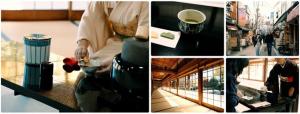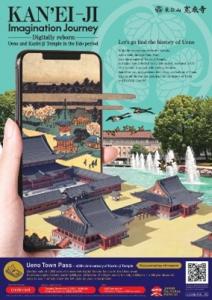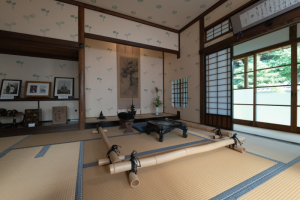'EDO SHOGUN’S LEGACY TRAIL TOUR' to Bring Shogunal Heritage to Tokyo’s Ueno Yanaka Area from November 2025
JAPAN, October 15, 2025 /EINPresswire.com/ -- Participants will enjoy a special viewing of “Eigaku Soryu(Eigaku Twin Dragons) at Kan'ei-ji Temple during its 400th anniversary along with a matcha tea experience and a stroll through the Yanaka Ginza District
JTB Corporation welcomes international travelers to participate in the launch of the “EDO SHOGUN’S LEGACY TRAIL TOUR,” an English-guided walking experience that brings to life the history and culture of Japan’s Edo period. The special program will be offered from November 2025 through January 2026 in Tokyo’s Ueno–Yanaka district.
Participants will have the opportunity to experience the rich history of the Tokugawa shoguns on the “EDO SHOGUN’S LEGACY TRAIL TOUR” at Tōeizan Kan'ei-ji Temple in Ueno, Tokyo. The tour’s centerpiece is the special viewing of “Eigaku Soryu(Eigaku Twin Dragons)” a stunning ceiling painting by contemporary Japanese artist Yuji Tezuka, created to celebrate the temple’s 400th anniversary..
Visitors will gain exclusive access to areas usually closed to the public, including the mausoleums of past Tokugawa shoguns and the Aoi Room, where the last shogun, Tokugawa Yoshinobu, spent the final years of the samurai era.
After enjoying a traditional matcha tea experience at the temple, guests can stroll through the nostalgic streets of Nippori and explore the charming Yanaka Ginza shopping street, guided to select shops offering unique local foods and souvenirs.
As part of the 400th anniversary commemorative projects, Kan'ei-ji Temple will introduce the smartphone-based content " KAN‘EI-JI Imagination Journey,” which allows visitors to enjoy reconstructions of historical temple buildings through ukiyo-e prints and CGI visualizations. In addition, a special value pass offering discounts at shops and restaurants in the Ueno area will be available for purchase.
Those interested can learn more about the full experience on the official Kan'ei-ji Temple 400th Anniversary website.
Official Kan'ei-ji Temple 400th Anniversary Website
https://kaneiji.jp/400thanniversary/english.html
「KAN‘EI-JI Imagination Journey」Website
https://kaneiji-imajour-lp.taks-task.jp/en/
Highlights & Features of the EDO SHOGUN’S LEGACY TRAIL TOUR
Special Viewing of “Eigaku Soryu(Eigaku Twin Dragons)”: Participants can admire the stunning ceiling painting at Kompon Chudo (Main Hall).
Interaction with Kan'ei-ji Temple Monks: During the tour, attendees can insights from temple monks during the tour.
Access to Normally Closed Areas: Visitors will be able to explore the mausoleums of the Tokugawa shoguns and the historic Aoi Room.
Cultural Experience: Sightseers on the tour can experience a traditional matcha tea ceremony while overlooking Kan'ei-ji Temple’s serene courtyard.
Walking Tour & Local Exploration: Tour guests will have the opportunity to stroll through the Nippori area (via Okakura Tenshin Memorial Park and Kannonji Temple’s historic walls) and discover the nostalgic Yanaka Ginza shopping street.
The tour operates in a small-group format with English-speaking guides for a comfortable, in-depth, enriching experience.
EDO SHOGUN’S LEGACY TRAIL TOUR – Tour Overview
Name: EDO SHOGUN’S LEGACY TRAIL TOUR
Dates: November 13, 2025 – January 22, 2026
Time: 1:00 PM – 4:00 PM daily
Group Size: 2–10 participants per tour
Price: ¥19,900 per person
Language: English
Reservations: Booking can be made through the official website here.
Booking Period: November 4, 2025 – January 14, 2026 (up to 7 days before the tour date)
Notes:
Please refer to the official website for full details.
This tour involves walking. Guests with mobility concerns should take caution.
For Inquiries About the Tour
JTB Corp., Tokyo Central Branch
Email: kaneiji400(at)jtb.com
Hours: Weekdays, 9:30 AM – 5:30 PM JST
About the Shoguns and the Tokugawa Family
The title of “Shogun” was bestowed by the Emperor of the Imperial Court and referred to the supreme military commander who governed the nation. When people speak of the “Shoguns of Edo,” they are referring to the Tokugawa shoguns, from Tokugawa Ieyasu through the fifteenth shogun Tokugawa Yoshinobu.
For a period of nearly 700 years, from the late 12th century to the late 18th century, Japan was ruled by military governments. Among them, the Tokugawa shoguns held power on the largest scale and for the longest period. After defeating Toyotomi Hideyoshi in battle and unifying the country, Tokugawa Ieyasu was appointed Sei-i Taishōgun (Great General) in 1603 and established his shogunate in Edo (present-day Tokyo). From that time until 1868, when the fifteenth shogun Tokugawa Yoshinobu returned political authority to the Emperor, the Tokugawa family governed Japan in what came to be known as the Edo Period.
The Tokugawa shogunate maintained a remarkably stable government for 265 years. Ordinary people were spared from the turmoil of power struggles and enjoyed a peaceful life in which the economy and culture flourished. Iconic elements of Japanese culture, such as ukiyo-e woodblock prints and kabuki theater, also emerged during this era.
Because of their formidable military power and the cultural legacy of the Edo Period, many Japanese today immediately associate the word “Shogun” with Tokugawa Ieyasu and the Tokugawa family.
About Kan'ei-ji Temple
Kan'ei-ji Temple is a prominent temple of the Tendai sect, established as a special head temple in Ueno, Tokyo. It was founded in 1625 by Great Master Tenkai(Jigendaishi Tenkai Daisoujou), a trusted advisor to the first three Tokugawa shoguns (Ieyasu, Hidetada, and Iemitsu), to pray for the peace and prosperity of the Tokugawa shogunate and the people of Japan. After the mausoleum of the fourth shogun, Tokugawa Ietsuna, was built, Kan'ei-ji Temple also became the Tokugawa family’s bodai-ji (family temple), cementing its close ties with the shogunate.
At the height of its influence, Kan'ei-ji Temple was one of Japan’s largest and most prestigious temples, occupying around 100 hectares and extending across what is now Ueno Park. Some historic structures, such as Kiyomizu Kannon-do and Shinobazu Pond’s Benten-do, still remain today.
However, due to its strong association with the Tokugawa family, the temple faced near destruction at the end of the Edo period during the political reforms that ended samurai rule and sought modernization. Much of its architecture was burned in battles, and land was confiscated by the new government.
However, after about ten years, Kanei-ji Temple was allowed to be rebuilt. Today, the Main Hall (Kompon Chudo) and its neighboring structures have been restored. Having narrowly survived repeated disasters and wars, they continue to preserve many cultural treasures. Notably, the Aoi Room and the shoguns’ tombs and pagodas remain intact, offering visitors a tangible connection to the era of the Edo shoguns.
About the“Eigaku Soryu(Eigaku Twin Dragons)” Ceiling Painting and Artist Yuji Tezuka
The “Eigaku Soryu(Eigaku Twin Dragons)” ceiling painting at Kompon Chudo (Main Hall) is a centerpiece of the temple’s 400th anniversary celebrations. Unlike traditional ceiling paintings in historic Japanese buildings, which are usually created by affixing painted Japanese paper to the ceiling. This remarkable work was painted directly onto wooden panels after removing the ceiling boards, an unusual technique in Japanese art history that is considered a rare and noteworthy achievement.
The painting, completed over three years, was dedicated to Kanei-ji Temple in October 2025. Visitors looking up at the ceiling will feel as if the two dragons are descending from the heavens, creating a powerful and immersive experience.
The artist, Yuji Tezuka, is one of Japan’s leading contemporary Nihonga (Japanese-style) painters. A disciple of Ikuo Hirayama, Tezuka holds the highest rank in the Nihon Bijutsuin, one of Japan’s foremost art organizations, and serves as an Honorary Professor at Tokyo University of the Arts, Japan’s top art university. Having a long-standing relationship with Kanei-ji Temples chief priest, Masaaki Urai, Tezuka was personally commissioned to create this 400th-anniversary masterpiece. After inspecting the Main Hall, he proposed this challenging direct-on-wood technique himself.
This monumental work by one of Japan’s most celebrated contemporary artists is a must-see for anyone interested in Japanese art and culture.
TAKASHI MURAKMI KK KARTZ MEDIA WORKS
Global PR Wire
+81 3-6427-1627
email us here
Legal Disclaimer:
EIN Presswire provides this news content "as is" without warranty of any kind. We do not accept any responsibility or liability for the accuracy, content, images, videos, licenses, completeness, legality, or reliability of the information contained in this article. If you have any complaints or copyright issues related to this article, kindly contact the author above.



